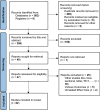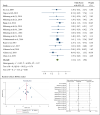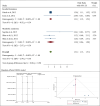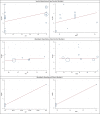Association of Helicobacter pylori infection with the risk of metabolic syndrome and insulin resistance: an updated systematic review and meta-analysis
- PMID: 34922625
- PMCID: PMC8684139
- DOI: 10.1186/s13098-021-00765-x
Association of Helicobacter pylori infection with the risk of metabolic syndrome and insulin resistance: an updated systematic review and meta-analysis
Abstract
Background: Conflicting results of recent studies on the association between Helicobacter pylori (H. pylori) infection and the risk of insulin resistance and metabolic syndrome explored the need for updated meta-analysis on this issue. Therefore, this systematic review aimed to estimate the pooled effect of H. pylori infection on the risk of insulin resistance and metabolic syndrome.
Methods: To identify case-control studies and cohort studies evaluating the association of H. pylori infection with insulin resistance and metabolic syndrome, a comprehensive literature search was performed from international databases including Medline (PubMed), Web of Sciences, Scopus, EMBASE, and CINHAL from January 1990 until January 2021. We used odds ratio with its 95% confidence interval to quantify the effect of case-control studies and risk ratio with its 95% CI for the effect of cohort studies.
Results: 22 studies with 206,911 participants were included for meta-analysis. The pooled estimate of odds ratio between H. pylori infection and metabolic syndrome in case-control studies was 1.19 (95% CI 1.05-1.35; I2 = 0%), and in cohort studies, the pooled risk ratio was 1.31 (95% CI 1.13-1.51; I2 = 0%). Besides, case-control studies showed the pooled odds ratio of 1.54 (95% CI 1.19-1.98; I2 = 6.88%) for the association between H. pylori infection and insulin resistance.
Conclusion: In this meta-analysis, the results showed that there was a possibility of metabolic syndrome and insulin resistance in case of H. pylori infection.
Keywords: Helicobacter pylori; Insulin resistance; Meta-analysis; Metabolic syndrome; Systematic review.
© 2021. The Author(s).
Conflict of interest statement
The authors declare that they have no competing interests.
Figures





Similar articles
-
Association between Helicobacter pylori infection and metabolic syndrome: a systematic review and meta-analysis.J Dig Dis. 2016 Jul;17(7):433-40. doi: 10.1111/1751-2980.12367. J Dig Dis. 2016. PMID: 27273478 Review.
-
The association between Helicobacter pylori and obesity: a systematic review and meta-analysis of case-control studies.Clin Diabetes Endocrinol. 2021 Jul 10;7(1):15. doi: 10.1186/s40842-021-00131-w. Clin Diabetes Endocrinol. 2021. PMID: 34243821 Free PMC article.
-
Helicobacter pylori infection as a risk factor for diabetes: a meta-analysis of case-control studies.BMC Gastroenterol. 2020 Mar 24;20(1):77. doi: 10.1186/s12876-020-01223-0. BMC Gastroenterol. 2020. PMID: 32209055 Free PMC article.
-
A systematic review and meta-analysis of the prevalence of Helicobacter pylori in patients with diabetes.Diabetes Metab Syndr. 2020 Jul-Aug;14(4):601-607. doi: 10.1016/j.dsx.2020.05.009. Epub 2020 May 11. Diabetes Metab Syndr. 2020. PMID: 32417710
-
Is Helicobacter Pylori infection inversely associated with atopy? A systematic review and meta-analysis.Clin Exp Allergy. 2015 May;45(5):882-890. doi: 10.1111/cea.12404. Clin Exp Allergy. 2015. PMID: 25207960 Review.
Cited by
-
The interplay between Helicobacter pylori infection and rs738409 PNPLA3 in metabolic dysfunction-associated steatotic liver disease.PLoS One. 2024 Sep 23;19(9):e0310361. doi: 10.1371/journal.pone.0310361. eCollection 2024. PLoS One. 2024. PMID: 39312529 Free PMC article.
-
Sex-Specific Risk Factors Associated with Helicobacter pylori Infection Among Individuals Undergoing Health Examinations in China.Int J Gen Med. 2022 Jun 29;15:5861-5868. doi: 10.2147/IJGM.S367142. eCollection 2022. Int J Gen Med. 2022. PMID: 35791315 Free PMC article.
-
Bidirectional relationship between Helicobacter pylori infection and nonalcoholic fatty liver disease: insights from a comprehensive meta-analysis.Front Nutr. 2024 Aug 5;11:1410543. doi: 10.3389/fnut.2024.1410543. eCollection 2024. Front Nutr. 2024. PMID: 39161913 Free PMC article.
-
Helicobacter pylori infection increases the risk of nonalcoholic fatty liver disease in diabetic population.Front Nutr. 2023 Feb 1;10:1076579. doi: 10.3389/fnut.2023.1076579. eCollection 2023. Front Nutr. 2023. PMID: 36819677 Free PMC article.
-
The Gastric Connection: Serum Gastric Biomarkers, Metabolic Syndrome and Transition in Metabolic Status.J Inflamm Res. 2024 Sep 16;17:6439-6452. doi: 10.2147/JIR.S475352. eCollection 2024. J Inflamm Res. 2024. PMID: 39310898 Free PMC article.
References
-
- Goodwin CS, et al. Transfer of Campylobacter pylori and Campylobacter mustelae to Helicobacter gen. nov. as Helicobacter pylori comb. nov. and Helicobacter mustelaecomb.nov., respectively. Int J Syst Evol Microbiol. 1989;39(4):397–405.
-
- Czinn SJ. Helicobacter pylori infection: detection, investigation, and management. J Pediatr. 2005;146(3):S21–S26. - PubMed
-
- McColl KEL. Helicobacter pylori infection. N Engl J Med. 2010;362(17):1597–1604. - PubMed
-
- Malaty HM. Epidemiology of Helicobacter pylori infection. Best Pract Res Clin Gastroenterol. 2007;21(2):205–214. - PubMed
-
- Redlinger T, O'Rourke K, Goodman KJ. Age distribution of Helicobactor pylori seroprevalence among young children in a United Sates/MexicoBorder community: evidence for transitory infection. Am J Epidemiol. 1999;150(3):225–230. - PubMed
LinkOut - more resources
Full Text Sources

